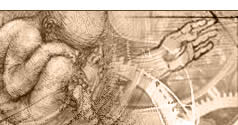 |
 |
 |
 |
 |
 |
 |
 |
|
 |
 |
 |
24 Modern sedimentology
|
| Menu | back |
Modern sedimentology confirms that the characteristic traits of the sediment strata, which are visible and accessible to researchers, point to short and intensive depositions. It would be difficult to validate the time periods of up to hundreds of millions of years on the basis of the observed sedimentary structures (cross bedding/graded bedding). A rethinking is also taking place with regard to the interpretation of ultra-fine strata. In many cases, people are talking in terms of days rather than years.
On May 24, 2002, at the International Solomon University in Kiev (Ukraine), the question: Is macro evolution and progressive evolution fact? was debated for the second time. Ten different speakers gave their views on the subject. Especially worth mentioning, is the geologist A.V. Lalomov, director of the geological research laboratory ARCTUR in Moscow, who advocated a short time geology without compromise.
In his opinion, modern sedimentology confirms that the true traits of the sedimentary strata that are visible and accessible to research (as opposed to the gaps between the strata which provide nothing observable or researchable) demonstrate short and intensive depositions (1).
It is interesting that, for several years, Russian scientists (primarily those in search of natural resources) have increasingly started to doubt the model of a billion-year-old Earth. It is interesting because the former Soviet Union was a bastion of atheistic evolutionary thinking.
Cross bedding:
The structures of deposited sediment allow clues to the speed with which they were deposited. Cross bedding occurs by way of fast-flowing water, regardless of how big the areas are. The more water involved in this process, the deeper the layers created. Cross bedding can be observed from an extent of a few centimetres, up to a depth of 20 m. A large proportion of sediment throughout the world is cross-bedded.
Graded bedding:
At the lowest level, graded bedding strata contain coarse material, which becomes finer towards the top. Graded bedding layers must come into existence within hours, days and weeks. They are created during the abating of a flood in the course of which the speed of the water slowly diminishes. Coarse material is moved and deposited at higher water speeds, fine material at lower speeds. Another large proportion of sedimentary layers throughout the world is graded bedded.
Depositing of finest strata:
The scarcely millimetre thick paper shale in the Saar-Pfalz Permian strata in Germany can, according to recent findings, be interpreted as light silts and dark clays with organic matter, which are produced on an alternating daily basis. Daily storms produced turbidity sediments and graded silts (2).
Missing deposition interruptions:
The Schmiedefeld Formation (Ordovician from Thuringia) is, for example, conventionally quoted as having taken twenty million years to come into existence (3). However, as regards to this formation, no long deposition interruptions are discernible, but rather indications of continuous, even relatively rapid sedimentation. That leads, in long-term understanding to a scarcely resolvable contradiction between rapid sedimentation (high sedimentation rate), a low overall depth and a long development time. The findings indicate a development time of only centuries rather than millions of years (4).
These 25 | Menu |
back
|
References:
|
| (1) |
Alexander Lalomov et al., Soviet scientists and academics debate Creation-evolution issue, Technical Journal 17/1, 2003, pages 6769. |
| (2) |
Andreas Schäfer, Klastische Sedimente, München, 2005, page 171f. |
| (3) |
M. Menning & Deutsche Stratigraphische Kommission, Stratigraphische Tabelle von Deutschland 2002, Potsdam, 2002. |
| (4) |
J. Ellenberg, Die Bildung oolithischer Eisenerze im thüringischen Ordovizium, Geowiss. Mitt. v. Thüringen, Beiheft 9, 2000, pages 5782. | |
| |
Note:
With respect to the matters discussed in this chapter I want to refer to the video "Drama in the Rocks".
|
| |
Comment this Site!
|
 |
 |
 |
 |
|

